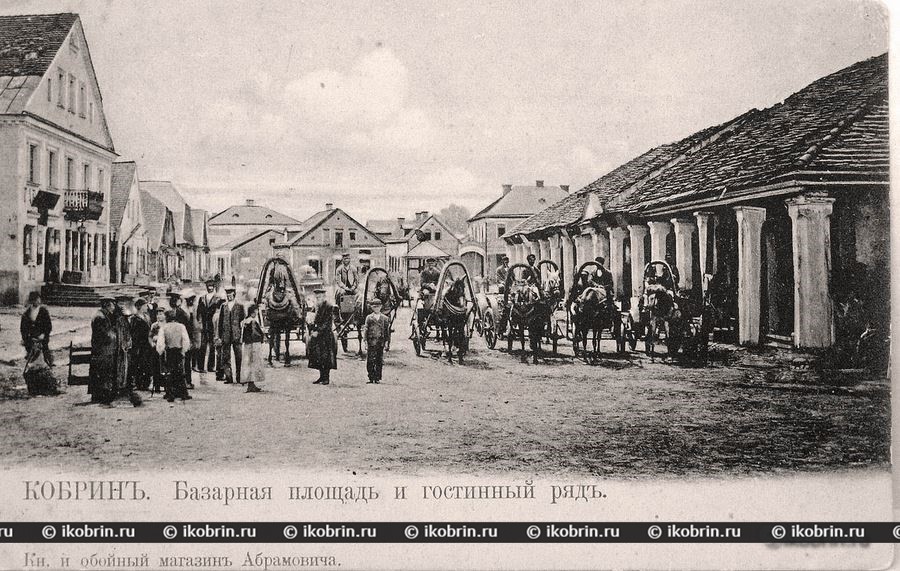Articles about Kobrin: 1917 - 1941
Kobrin at the time of Poland
Kobrin before war represented the small district town as a part of the Polesia voivodeship. In 1935 the population of our city made about 11 thousand. From them about 6-7 thousand – Jews. Till 1939 in Kobrin there were two small movie theaters "Ebrama" (today the former movie theater known for much "on September 17") and "Baize". The building of Bayka movie theater belonging to Freytskis stood still present shop "Sputnik". All members of the family of the owner worked at movie theater. Only two persons – the operator and the cleaner – were hired. Usually in the evenings passed 2-3 sessions. On viewing of the movie it was possible to get at any time and to enjoy all three sessions without additional fee. The new movie was always followed by an agiotage, and the ticket for it was more expensive. Several days when visitors became less, later the owner dumped the price to 10 pennies (for comparison: the loaf of bread cost 20). Generally at movie theaters twisted movies of the western production. Unprecedented interest caused the Soviet movie "Volga-Volga" in due time. At this time Kobrin was in structure of Poland, and it was interesting to people to learn about life in the Soviet Union. Unfortunately, during war of 1941-45 the building of Bayka movie theater burned down.

Market square and Brestskaya Street
More than half a century back in the city 5 paid public libraries in which there were about 7 thousand books worked. At A.Nevsky's cathedral in the brick house the Russian library was placed. Polish was on Pervomayskaya St. (in the past - the building of a kozhvendispanser). Also in Kobrin worked the Jewish and trade-union libraries. By the way, in the 20th years different public associations organized more than 50 national reading rooms at which theatrical and choral circles actively worked.

Congress of Magistrates of the Kobrino-Pruzhansky District
Till 1939 in Kobrin on st. on September 17 there was the first private newsstand of Berg in which the cheapest newspaper cost 20 pennies. The printing house paid percent from sale of newspapers to the owner of a booth. Average day earnings made 2 zloties. It should be noted that the cost of the newspaper was very high in comparison with a salary therefore not everyone could get it. But our people always differed in sharpness: it acquired the Belarusian, Polish, Ukrainian and Russian newspapers "Za Svobodu", "Varshavskaya", "Vilenskaya" by sharing the cost. To raise the income, Berg began to rent newspapers. Soon the printing house suspected something wrong and invented a new way of protection: newspapers began to seal up so that it was impossible to read them, without having removed a seal.
The wooden building of mail was at the place of present city court. Transfer of the letter within the country managed to a kobrinchanin in 30 pennies, and abroad – 60 (for comparison: two eggs cost 10 pennies). Almost nobody subscribed to newspapers, magazines and books in the city.
In 1931-32 about 115 thousand people lived in the Kobrin County. At that time there were 104 schools at which 12 thousand pupils were trained. A half of schools gave three-cool education, the others - only initial knowledge. In the city there was a gymnasium in which studied for quite high payment of 350-400 people. At first it settled down in the wooden building around the present museum. Then our compatriot writer Maria Radzevich from Grushevo's manor offered the funds for a new gymnasium (now the 1st school) in which the salary of the teacher made 120 zloties. Besides, in 1935 in Kobrin the semiletka was constructed (No. 2 SOSh now).
Also in the city at meeting-houses there were Jewish religious schools ("heder" - initial and "eshibota" - averages). And in the mid-thirties commercial and vocational schools on present Pervomayskaya St., and also two-cool training courses for receipt in teacher's seminary opened (the house in Puganov's square). At that time the elementary school teacher received 120 zloties a month, and the teacher of a gymnasium – 200-250.
City streets were lit with lamps from small power plant. The electricity and candles cost much. Used oil lamps in case of big need. Told that one grammar-school girl from economy prepared lessons under a streetlight.
The radio receiver at that time cost too very much - 400-450 zloties. Therefore it was redeemed on credit. It was necessary to pay a tax of 3-5 zloties a month therefore it was often masked on an attic for the antenna. For advertizing in shop gave the receiver for several weeks. Many with pleasure used it: listened to music and news.
As technical novelties it were too expensive for the majority, generally to the kobrinchena had a good time singing and dances at parties. Sang everywhere and with big hunting. Our city more than half a century was it back.
A. E. Kalita, Kobrin-inform newspaper
Comments
Names of articles
Search in the website
Our partners
Our projects: Tourist Kobrin | Intellectual Kobrin
All rights reserved © 2011-2015. All images are protected by their owners.
When copying materials the active reference to http://ikobrin.ru is obligatory.

